Abstract
As a natural biomass material, bamboo is subject to variations in culm size as well as in physical and mechanical properties that substantially influence processing and product quality. The diameter, thickness, and hardness of bamboo culms are critical factors for the output and quality of flattened bamboo board (FBB). In this study, the effects of different hardness modulus (HM) grades on the physical and mechanical properties of FBB were examined. The results showed that the HM of Moso bamboo (Phyllostachys pubescens) followed a normal distribution. Nine grades of HM could be divided by an interval of 5 KN/mm2. The physical and mechanical properties of FBB were positively correlated with the HM of bamboo culms. Compressive strength, tensile strength, and shear strength, as well as the bending properties of FBB, each increased with increasing HM. Furthermore, under the same conditions, the mechanical properties of FBB were superior to those of both bamboo strips and bamboo culms. The softening, flattening, and planing processes were beneficial in improving the performance of bamboo. The strong correlation between HM and the properties of FBB indicates that the HM grading of bamboo culms can be used in bamboo processing to produce high-quality FBB products with uniform performance.
1. Introduction
Because of its fast growth, short growth cycle, and high mechanical strength [1,2,3,4], bamboo has great application prospects as engineering structural material or home decoration material. Flattened bamboo board (FBB) is a rectangular section of bamboo board that is made from round bamboo culms or arc bamboo strips (part of the round bamboo culm), using processes where bamboo culms are cut, softened, flattened, dried, and shaped [5]. Because of the natural bamboo grain and the physical properties, as well as the larger cross-sectional size of FBB compared with bamboo strip, bamboo bundle, and bamboo strand, FBB is widely used in the manufacture of chopping boards, furniture, flooring, and decoration [5]. According to the process of FBB fabrication, the diameter and wall thickness of bamboo culms most greatly influence the softening process parameter level and the utilization rate of bamboo culms [6]. The basic properties of bamboo culms are another key factor in FBB quality [5].
As a natural biomaterial, the size and structure of bamboo, as well as its physical and mechanical properties, vary greatly across different bamboo species, ages, locations, and growing conditions [6,7,8,9]. For instance, in the case of Moso bamboo (Phyllostachys pubescens), the stem diameter of bamboo grown in the same area was found to range from 6 to 15 cm [10]; the basic density increased from 0.70 g/cm3 to 0.79 g/cm3 from the bamboo culm base to the top [11,12] and the compressive strength increased from 45 MPa to 65 MPa [13,14]. Additionally, the drying shrinkage rate of bamboo volume was found to decrease from 14.91% to 7.88% from 0.5 to 6 years of bamboo age [15,16]. The tensile elastic modulus and the strength of bamboo strip from the inner to outer culm layers in a longitude direction were found to increase from 8.49 GPa to 32.49 GPa and from 115.94 MPa to 328.15 MPa [17,18], respectively. The variability in bamboo structure and properties has an important influence on the processing, product quality, and uses of bamboo.
Grading refers to the process of sorting every piece of bamboo within a sample into grades, according to defined selection criteria. ISO/TR 22157-2:2004 [19] and ISO 19624:2018 [20] identify dimensional, visual, geometric, mechanical, and physical properties that reflect the mechanical strength or structural capacity of a bamboo sample and may affect the utility of the resulting products. These criteria specify grading procedures for visual and mechanical sorting and include pole bamboo for structural applications. Observable characteristics of bamboo culm, such as diameter, taper, ovality, and thickness, can be visually sorted. Generally, bamboo culms with diameters > 12 cm are considered large-diameter bamboo; diameters of 9–11 cm are considered medium-diameter bamboo; and diameters of 6–8 cm are considered small-diameter bamboo [19]. The taper of bamboo culms is typically graded into medium level (−0.17% to 0.09%, 0% to 0.1%) and higher level (0.09% to 0.43%, 0.1% to 0.5%) [21].
Based on bending and shearing strengths, the bamboo culms from the species Guadua amplexifolia could be sorted into two applied strength levels in a structural components’ appliance [22,23]. India’s national building regulations grade bamboo culms for structural application according to their elastic modulus and strength. However, the hardness modulus (HM) represents the entirety of the physical properties of the gradient bamboo culm cross-section and correlates well with its mechanical and physical properties. HM allows for a statistically significant prediction of the mechanical and physical properties of the samples within a grade [24].
Corresponding to a particular bamboo resource, grading is very important to meet the requirements of a specific end use or specification. In this study, round bamboo culms were graded by HM. The corresponding relationship between HM and the physical and mechanical properties of FBB are discussed. The aim of this study was to provide a theoretical basis for the optimum use of bamboo and high-quality FBBs.
2. Materials and Methods
2.1. Materials
Two hundred 4-year-old Moso bamboo (Phyllostachys edulis) culms with diameters of 100–140 mm were harvested from Gao’an City, Jiangxi Province, China. The culms were free from pests and diseases. Sections of 2.0–5.0 m above base of all 200 fresh bamboo culms were cut off for sample preparation. Three culm sections at 1.05 m, 100 mm, and 1.05 m were cut successively and used to make FFB (The yellow ① in Figure 1A), HM testing specimens(The red ③ in Figure 1A), and FFB (The yellow ② in Figure 1A), respectively. During the cutting process, bamboo nodes were avoided at both ends of the culm sections that were used for HM testing.
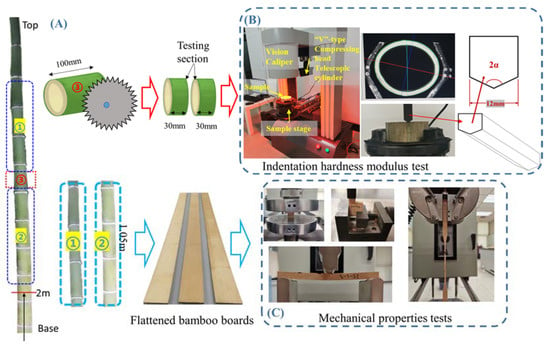
Figure 1.
Schematic diagram of the utilized materials and methods. (A) Preparation of specimens. (①②③ are three culm sections from the same bamboo) (B) Testing of indentation hardness modulus (HM). (C) Mechanical properties testing of flattened bamboo boards (FBB).
2.2. Test Method of Indentation Hardness Modulus
To prepare specimens for indentation HM testing, the 100 mm-long bamboo culm sections were cut and planed to a final height of 30 mm with smooth and parallel surfaces. Both surfaces of 30 mm-high bamboo culm sections were perpendicular to the axis (Figure 1A). The test surface was formed by the adjacent faces of two specimens of one culm section.
HM tests were performed on a domestic testing machine (TENSON, WDW-T50, Jinan, China) equipped with a load cell with a capacity of 10 KN. For a hollow, thin wall specimen, a V-shaped compressing roller was used for HM testing. Before testing, a specimen was fixed on the sample platform and centered by a centering device. Then, the axis length, ovality, and wall thickness of the testing surface were measured by photographing and using a visual caliper (Figure 2). The compression head was loaded at a displacement rate of 3 mm/min until a displacement of up to 3 mm was reached. The compression load and V-shaped head indentation depth were recorded during the process. The dimension of the V-shaped pressure head is shown in Figure 2B.

Figure 2.
HM test sample and its cross-section.
The HM was defined as a factor that indicates the stiffness of a whole bamboo culm cross-section with gradient fiber content. HM is similar to the elastic modulus of the hardness of a material. It reflects the slope of compressive load-indentation linear relationship curves in the compression head pressing of bamboo culms [25]. The calculation formula is as follows:
where KV is the HM of bamboo (MPa), P is the compressing load (N), t1 and t2 are the wall thicknesses of the bamboo culm where the pressure head is directing the pressure (mm), and α is the angle of the V-shaped pressure head (in this study α = 60°).
2.3. Physical and Mechanical Properties Testing of Flattened Bamboo Boards
For the manufacturing process of FBBs (Figure 3), bamboo culms were cross-cut into standard culm sections with a length of 1.3 m, then longitudinally sawed into 2–5 equal arc splits. Before flattening, the arc bamboo strips were softened in a sealed container with a steam pressure of 0.98 (corresponding to 180 °C). The required softening time depended on the wall thickness; for example, a bamboo culm wall with 12 mm thickness needed a softening time of 350–360 s. During the flattening process, the softened arc bamboo culms were expanded by a pressing roll, the outer and inner layers were sliced by arc shapers on the top and the bottom of bamboo culms, and the culms were flattened through multiple sets of gradually flattening arc rolls and pressure rolls. The flattening process is shown in Figure 4. After the flattening process, the flattened bamboo boards were neatly stacked and dried in a drying kiln until the moisture content was reduced to 12%.
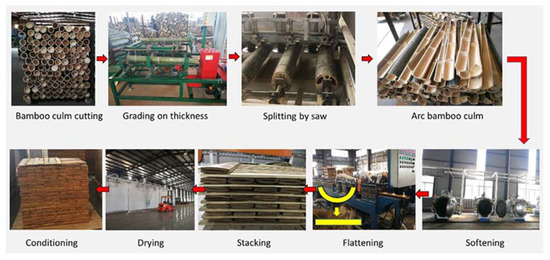
Figure 3.
Process of FBB production.
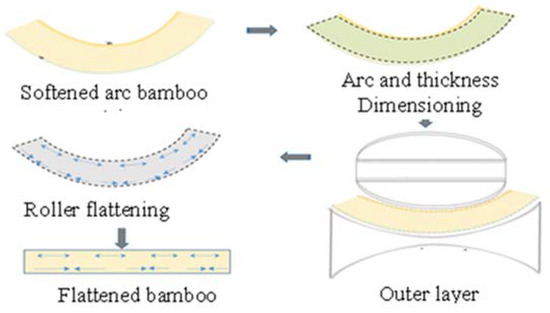
Figure 4.
Diagram of the flattening process of arc bamboo slices.
Based on the results of HM grading, HM35, HM45, HM55, HM65, and HM75 bamboo culms were selected to prepare FBBs. Physical mechanical property tests were conducted on each grade of FBBs. The FBBs corresponding to each HM grade had at least 6 samples in each experiment. A relationship was found between HM grades of bamboo culms and the properties of the resulting FBBs.
With reference to GB/T 15780-1995, “Testing methods for physical and mechanical properties of bamboos” [26], the tensile strength, compression strength, bending performance, and shear strength were tested using an Instron series 5582 test machine (Instron, Boston, MA, USA) equipped with a test sensor with a capacity of 10 KN. Before testing, all physical testing specimens were stored at 20 °C and 65% relative humidity for at least 2 weeks. At least six specimens were tested for each test.
3. Results and Discussion
3.1. Hardness Modulus Distribution of Bamboo Culms
Figure 5A shows typical load-indentation depth relationship curves of nine grades of 400 specimens, presenting a good linear relationship. However, the slopes of different curves differed widely among grades, suggesting that the HM of bamboo culm can reflect the variability in bamboo culm performance.
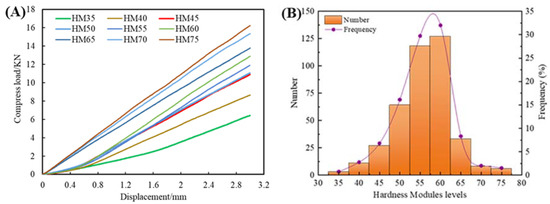
Figure 5.
Results of HM tests of bamboo culms. (A) Typical load-indentation depth relationship curves of HM tests. (B) Quantity distribution of Moso bamboo HM levels.
The HM values of the tested bamboo culm specimens followed a normal distribution (Figure 5B) and varied greatly, with the maximum value (79.1 KN/mm2) that was twice that of the minimum value (37.4 KN/mm2). According to the use of HM as a grading criterion for a given grade of bamboo culms, nine grades were applied with an interval of 5 KN/mm2 [25]. The HM grading levels and quantities of 400 bamboo culms are shown in Table 1. The normal distribution of HM shown in Figure 5B indicates that HM50, HM55, and HM60 accounted for the highest proportion (up to 78%). In contrast, the lowest and highest grades (HM35, HM40, HM70, and HM75 with HM less than 40 KN/mm2 or greater than 70 KN/mm2), accounted for only 7%. Therefore, HM grading could provide a statistically significant predication of the properties of bamboo culms, which would be very useful for the FBB-processing industry. According to this HM grading, bamboo culms can be graded into high-grade, medium-grade, and low-grade, which can be softened and flattened using different processing parameters to improve the output and quality of the fabricated FBBs.

Table 1.
Statistics and grading levels of hardness modulus (HM).
3.2. Influence of Hardness Modulus on Physical Properties of Flattened Bamboo Boards
3.2.1. Relationship between Hardness Modulus and Density of Flattened Bamboo Boards
A strong positive correlation was found between the HM of bamboo culms and FBB density (Table 2; Figure 6). The oven-dried density of FBB ranged from 0.70 to 0.93 g/cm3 and the air-dried density was generally slightly higher than the oven-dried density. Both the FBB oven-dried density and the air-dried density increased with increasing HM grades. Fiber content gradually decreased in the radial direction of bamboo culm cross-sections, from outer to inner layers [15]. The air-dried densities of outer and inner Moso bamboo strips at 2 m were 0.95 g/cm3 and 0.4 g/cm3, respectively [11]. Compared with the natural Moso bamboo strip density distribution range, the density range of FBB was reduced to 0.71–0.95 g/cm3 by removing fiber-dense and fiber-sparse parts of the bamboo culm during the planing process.

Table 2.
Densities of flattened bamboo boards (FBBs) with different HM levels.
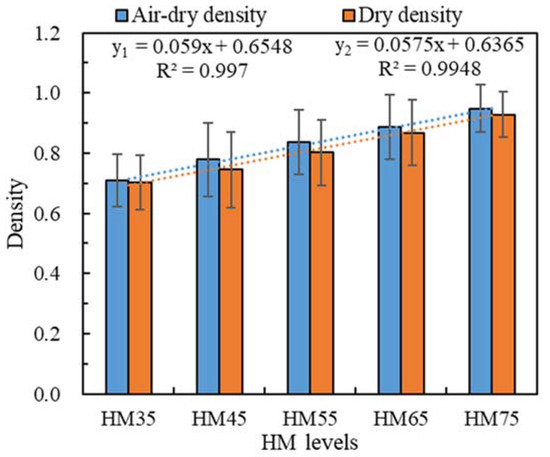
Figure 6.
Relationship between HM levels and FBB density.
The HM of bamboo culms presents the compressive resistance of the bamboo culms cross-section. The density of bamboo culm is an important factor for HM. The linear function formulae of HM with air-dried density and oven-dried density were y = 0.059x + 0.655 (R2 = 0.997) and y = 0.0575x + 0.637 (R2 = 0.995), respectively. The relationship between bamboo density and HM was similar to that of wood density and hardness, both of which were positively correlated. It is possible that the density and distribution of fibers result in higher HM in areas with dense fibers. According to the gradient composite structure of the bamboo culm, conventional local hardness tests are not applicable to bamboo culms. Therefore, HM incorporates the whole cross-section properties of bamboo culms and, thus, it is suitable for grading bamboo culms. The good correlation between FBB density and bamboo culms’ HM indicated that FBBs with different densities could be produced by using HM grading of bamboo culms, which makes this grading convenient for further use.
3.2.2. Relationship between Hardness Modulus and Shrinkage of Flattened Bamboo Boards
Shrinkage is a key factor that affects the cracking, warping, and deformation of bamboo and wood during drying and use. The shrinkage of FBBs decreased with the improving HM grade. The tangential and radial shrinkage of FBBs for different HM grades is shown in Figure 7. Both air-dried and oven-dried shrinkage rates in the tangential and radial directions of FBBs decreased with improving HM grades. The oven-dried shrinkage rate of HM35 in the radial direction reached a maximum of 16.17%, while that of HM75 in the tangential direction had a minimum of 7.34%. Hydroxyl groups in FBBs with higher density decreased more strongly during the softening process, compared with lower-density FBBs, resulting in a decrease in the shrinkage rate [27].
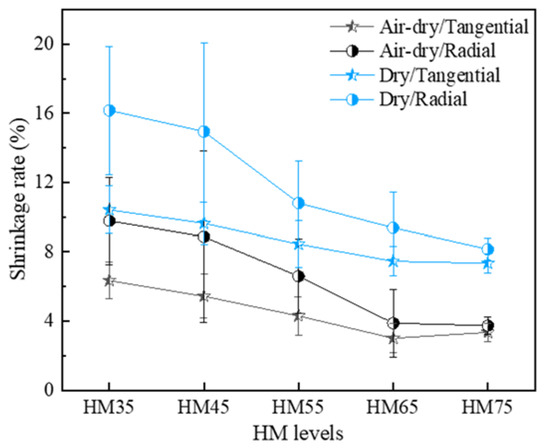
Figure 7.
Relationship between HM levels and FBB shrinkage rate.
The oven-dried shrinkage rates of FBBs exceeded those of air-dried FBBs. For the same HM grade, the shrinkage rates of FBBs were larger in the radial direction than in the tangential direction under both drying conditions. This result was consistent with the results reported in previous studies [28,29] on the shrinkage of several species of bamboo, which showed that the shrinkage rates were slightly larger in the radial direction than in the tangential direction. The variance between radial and tangential shrinkage gradually decreased with the increasing HM level. For the HM75 grade, the radial shrinkage rate of FBBs was only 12% higher than it was in the tangential direction, while the radial shrinkage of HM35 was 54% higher. Generally, the shrinkage rate of wood is larger in the tangential direction than in the radial direction, but in different studies, bamboo shrinkage has been found to vary [30]. Unlike untreated wood and bamboo, FBBs are boards with regular cross-section that are prepared by flattening the arc surfaces of bamboo culms under external forces after high-temperature softening treatment. During the flattening process, bamboo culms are compressed in the radial direction. This process results in greater rebound and wet expansion of dried FBBs during the soaking process and a larger shrinkage rate in the radial direction than in the tangential direction during the second drying process. This phenomenon differs from the shrinkage phenomenon of untreated wood and bamboo.
3.3. Influence of the Hardness Modulus of Bamboo Culms on the Mechanical Properties of Flattened Bamboo Boards
3.3.1. Influence of Hardness Modulus on Compressive Strength of Flattened Bamboo Boards
The compressive strengths of FBBs fabricated with bamboo culms of different HM levels are shown in Figure 8A. There was a strong positive correlation between the HM of bamboo culms and the compression strength of the fabricated FBBs. The compressive strength in the axial direction increased with an increasing HM level. The maximum compressive strength of FBB reached 123.14 MPa in grade HM75, while the minimum compressive strength of FBB was 58.72 MPa for grade HM35. This result was consistent with the relationship between the indentation hardness and the compressive strength of bamboo, as reported previously [24]. Compressive strength represents the maximum capacity of bamboo to bear a compressive load along the axial direction under loads that are applied slowly for a short duration. Density is the main factor affecting the compressive strength of bamboo. Generally, the compressive strength increases with increasing bamboo density. The maximum compressive load and corresponding failure displacement both increased with increasing HM grades of bamboo culms (Figure 8B).
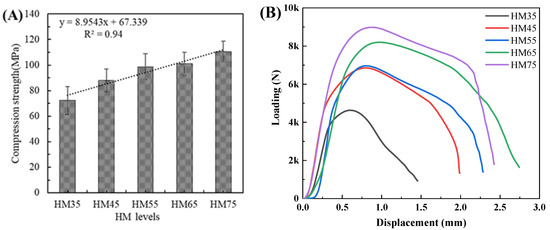
Figure 8.
Compression strength testing results. (A) Relationship between HM levels and compression strength of FBBs. (B) Typical load-displacement curves in compression testing.
The production process of FBBs contributed to the observed improvement in their compressive strength. The compressive strength of FBBs was higher than that of the bamboo block in the middle part of 4-year-old Moso bamboo samples (40–80 MPa) [11,31], as well as that of bamboo culm sections in the middle part of the same samples (55.23 MPa) [27] and that of fine planed bamboo strips (28.8 MPa) [32,33]. This was related to the preparation technology used to fabricate FBBs. First, during the steam softening process, the hydroxyl groups between cellulose molecule chains in the amorphous quasi-crystalline cellulose in the bamboo underwent a condensation reaction under high temperatures, causing the cellulose molecule chains to rearrange. In addition, the relative crystallinity of bamboo is improved by the formation of crystals in the non-crystalline zone [34]. Thus, the hardness and compression strength of FBBs both increased. Second, compared to the outer layer, more of the inner layer of bamboo was removed in the process of flattening and planing. Therefore, the production process of FBBs contributed more to the improvement of the compressive strength than the production processes of bamboo blocks, bamboo culm sections, and planed bamboo strips.
3.3.2. Influence of Hardness Modulus on Bending Properties of Flattened Bamboo Board
As shown in Figure 9, the bending strength and the maximum bending failure load of FBBs increased with increasing HM levels. There was a good positive correlation between the HM grades of bamboo culms and the bending properties of FBBs. The bending strength and modulus of elasticity (MOE) of FBBs reached maximum values of 243.52 MPa and 16.19 GPa in the HM75 grade, respectively. Meanwhile, the minimum values of bending strength and MOE appeared at the HM35 level, which were 112.26 MPa and 6.75 GPa, respectively. The maximum values were both more than twice the minimum values. The bending strength of bamboo—which is also known as static bending ultimate strength or flexural strength—characterizes the bending properties of bamboo under static loads. In the production process, the bending strength and plastic deformation of materials is often evaluated by bending tests. The bending strength is mainly determined by the difference between tensile strength and compressive strength in the axial direction. During the bending process, bamboo is often damaged by compression of the upper surface and tensile stress exerted on the lower surface. In the bending test, the typical L-D curve showed that the maximum failure load and the slope of the linear elastic section increased with an increasing HM grade (Figure 9B). Density is an important factor affecting the bending properties of bamboo. The FBB density was positively correlated with HM; therefore, the HM of the bamboo culm was also positively correlated with the bending properties of FBB.

Figure 9.
Results of bending strength testing. (A) Relationship between HM levels and bending strength of FBBs. (B) Typical load-displacement curves in bending tests.
Compared with bamboo strips, intact wall bamboo blocks, and bamboo culm sections, the bending modulus of elasticity and bending strength of FBBs were relatively higher. The reason for this was similar to why the compression strength of FBBs exceeded that of other bamboo elements and materials. The reason FBBs had higher bending strength with higher fiber content is its thermal treatment process and the removal of the inner layer during planing. The good positive correlation between HM levels and the bending performance of FBBs can determine the bending performance range of FBBs by grading the HM of bamboo culms.
3.3.3. Influence of Hardness Modulus on Tensile Strength of Flattened Bamboo Board
The relationship between the HM levels of Moso bamboo culms and the tensile strength along the grain of fabricated FBBs is shown in Figure 10A. A good correlation was found between HM grades and the tensile strength of FBBs. The tensile strength of the HM35 level reached at least 125.35 MPa, which was 50% higher than that of bamboo strip (83.72 MPa) with the highest density (0.85 g/cm3); the maximum tensile strength of the HM75 level reached 229.03 MPa, which was equivalent to that of the outermost bamboo layer with a fiber content of 50% [17]. The tensile strength of FBB had a higher linear correlation with HM levels (R2 = 0.96) than the compressive strength (R2 = 0.94). In the tensile test, the typical L-D curve shows that the maximum failure load and the slope of the linear elastic section both increased with increasing HM grades of bamboo culms (Figure 10B).
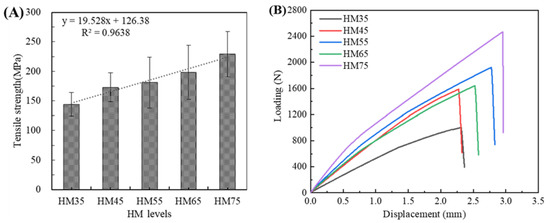
Figure 10.
Tensile strength testing results. (A) Relationship between HM levels and tensile strength of FBBs. (B) Typical load-displacement curves in tensile testing.
The density and axial tensile strength of FBBs were determined by the distribution density and strength of the axial vascular bundle. The tensile strength of FBBs in this study exceeded that of other bamboo elements and materials. The main reason for this result was the removal of the inner layer in the preparation of FBBs. The bamboo outer layer is the area with the highest fiber content and mechanical strength. FBBs retained more bamboo outer layer compared to fine-planed bamboo strips, which improved the mechanical properties of FBBs.
3.3.4. Influence of Hardness Modulus on Shear Strength of Flattened Bamboo Board
The relationship between the HM of bamboo culms and the shear strength of FBBs in the axial direction is shown in Figure 11A. The shear strength of FBBs ranged from 15.32 MPa to 32.47 MPa. The shear strength of FBB increased with increasing HM levels, and the maximum and minimum values appeared in levels HM35 and HM75, respectively. This was consistent with the results of the tensile–shear strength of bamboo strips for different density grades, indicating that the tensile–shear strength increased with increasing bamboo density [32,33]. The average shear strength of FBBs (14.5 MPa) was an order of magnitude lower than the tensile strength (134.1 MPa) and the bending strength (134.4 MPa) [8,10]. This was due to the axial arrangement of bamboo cells. Under axial shear stress, the main failure modes were interlayer shear failure and tearing, both of which resulted in a lower strength than in fiber tensile fracture. Therefore, the shear strength of FBBs along the grain was comparatively lower and the main failure and processing modes were axial cracking and longitudinal splitting.
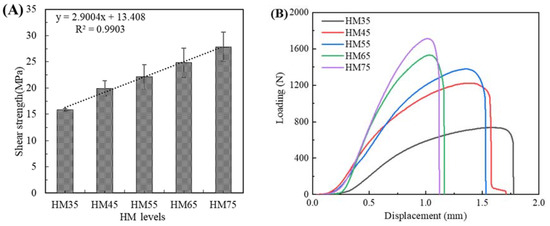
Figure 11.
Shear strength testing results. (A) Relationship between HM levels and shear strength of FBBs. (B) Typical load-displacement curves in shear testing.
The shear-load-displacement curve shown in Figure 11B indicates that the shear failure load increased and the displacement at failure decreased with increasing HM levels. During the flattening process, arc bamboo slices were compressed, resulting in a relatively higher fiber content in the FBB. Thus, more interlayer fiber failure occurred in the process of shear failure of FBB with larger HM and higher density. FBBs with a lower HM grade showed more bamboo parenchyma cell failure on the shear surface, resulting in a larger displacement before shear failure.
4. Conclusions
(1) The HM of Moso bamboo culms followed a normal distribution pattern, with a main distribution of 50–65 KN/mm2 that accounted for about 78% of all specimens. The distributions between 35–50 KN/mm2 and 65–70 KN/mm2 were relatively low, accounting for about 10% and 12% of total specimens, respectively. By using 5 KN/mm2 as the grading gradient, bamboo culms could be divided into nine HM levels.
(2) The HM of bamboo culms were positively correlated with the density of corresponding FBBs. However, HM was negatively correlated with the shrinkage of FBBs. With increasing HM, the shrinkage rate decreased. Moreover, the radial shrinkage rate exceeded the tangential shrinkage rate, which was related to the compression-flattening process of FBBs during preparation.
(3) The mechanical properties of FBBs were positively correlated with HM levels. With increasing HM, the compressive strength, tensile strength, shear strength, and bending strength all increased. Under the same conditions, the performance of FBBs was better than that of corresponding bamboo materials, bamboo strips, and bamboo culms. This improved performance was related to the process of removing a certain amount of bamboo from the inner layer and retaining a more fiber-rich bamboo in the outer layer during the preparation of FBBs.
(4) The good physical and mechanical correlation between the HM of bamboo culms and FBB indicated that high-quality FBBs with uniform performance can be produced through the proposed grading method of bamboo culms.
Author Contributions
Conceptualization, H.L. and X.Z.; methodology, X.C. and Y.Y.; software, Q.S.; data curation, Y.Z. and X.L.; writing—original draft preparation, Y.Z. and H.L.; writing—review and editing, Y.Z. and H.L. All authors have read and agreed to the published version of the manuscript.
Funding
This research was funded by the National Key Research & Development Program of China (2022YFD2200902) and by The Fujian Province Forestry Science and Technology Project (2022FKJ01).
Conflicts of Interest
The data presented in this study are available on request from the corresponding author.
References
- Yuan, T.; Liu, X.; Dong, Y.; Wang, X.; Li, Y. Determination of the Effects of Superheated Steam on Microstructure and Microme-chanical Properties of Bamboo Cell Walls Using Quasi-Static Nanoindentation. Forests 2021, 12, 1742. [Google Scholar] [CrossRef]
- Yuan, T.; Wang, X.; Lou, Z.; Zhang, T.; Han, X.; Wang, Z.; Hao, X.; Li, Y. Comparison of the Fabrication Process and Macro and Micro Properties of Two Types of Crack-Free, Flatten Bamboo Board. Constr. Build. Mater. 2022, 317, 125949. [Google Scholar] [CrossRef]
- Yuan, T.; Xiao, X.; Wu, Y.; Wang, X.; Liu, X.; Li, Y. Multi-Scale Analysis of Changes in Crack-Free Flattened Moso Bamboo After Saturated Steam Treatment and Flattening Process. Sci. Adv. Mater. 2021, 13, 1259–1267. [Google Scholar] [CrossRef]
- Tong, J.; Wang, X.; Kuai, B.; Gao, J.; Zhang, Y.; Huang, Z.; Cai, L. Development of Transparent Composites Using Wheat Straw Fibers for Light-Transmitting Building Applications. Ind. Crops Prod. 2021, 170, 113685. [Google Scholar] [CrossRef]
- Zhang, X.B.; Liu, H.R.; Zhang, F.D.; Jiang, Y.J.; Fang, C.H.; Fei, B.H. Analysis on the Key Technology of Longitudinal without Groove Integrated Bamboo Flattening. China For. Prod. Ind. 2021, 58, 43–47. [Google Scholar]
- Jiang, Z.H. Bamboo and Rattan in the World; Liaoning Science and Technology Press: Liaoning, China, 2002. [Google Scholar]
- Ghavami, K.; Rodrigued, C.S.; Paciornic, S. Bamboo: Functionally graded composite material. Asian J. Civ. Eng. 2003, 4, 1–10. [Google Scholar]
- Ray, A.K.; Mondal, S.; Das, S.K. Bamboo—A functionally graded composite-correlation between microstructure and mechanical strength. J. Mater. Sci. 2005, 40, 5249–5253. [Google Scholar] [CrossRef]
- Tan, T.; Rahbar, N.; Allameh, S.M.; Kwofie, S.; Dissmore, D.; Ghavami, K.; Soboyejo, W.O. Mechanical properties of functionally graded hierarchical bamboo. Acta Biomater. 2011, 7, 3796–3803. [Google Scholar] [CrossRef]
- Peng, X.B.; Ouyang, W.C. Effects of different site conditions on DBH and height of Phyllostachys pubescens. Chin. Hortic. Abstr. 2015, 10, 47–97. [Google Scholar]
- Li, Z.X. Research on Mechanics and Failure Properties of Moso Bamboo. Master’s Thesis, Chinese Academy of Forestry, Beijing, China, 2009. [Google Scholar]
- Zhou, Q.Y.; Ren, H.Q.; Li, X.Z.; Lou, W.L. Research on Variation of Air-dry Density of Bamboo. World Bamboo Ratt. 2009, 7, 18–21. [Google Scholar]
- Yu, H.Q.; Fei, B.H.; Ren, H.Q.; Jiang, Z.H.; Liu, X.E. Variation in Tensile Properties and Relationship between Tensile Properties and Air-Dried Density for Moso Bamboo. Sci. Silvae Sin. 2006, 42, 72–76. [Google Scholar] [CrossRef]
- Lo, T.Y.; Cui, H.; Leung, H. The effect of fiber density on strength capacity of bamboo. Mater. Lett. 2004, 58, 2595–2598. [Google Scholar] [CrossRef]
- Zhong, S.; Zhang, S.B.; Qin, D.C.; Luo, Z.H. Variation patterns of moisture content, basic density and dry shrinkage of Phyllostachys pubescens. J. Beijing For. Univ. 2009, 31, 185–188. [Google Scholar]
- Cui, M.; Yin, Y.F.; Jiang, X.M.; Liu, B.; Zhang, S.B. Variation analysis of physical characteristics in Phyllostachy pubescens stem at different growth ages. J. Fujian Coll. For. 2010, 30, 338–343. [Google Scholar]
- Liu, H.R.; Jiang, Z.H.; Zhang, X.B.; Liu, X.E.; Sun, Z.J. Effect of fiber on tensile properties of moso bamboo. Bioresource 2014, 9, 6888–6898. [Google Scholar] [CrossRef]
- Liu, H.R.; Jiang, Z.H.; Fei, B.H.; Hse, C.Y.; Sun, Z.J. Tensile behaviour and fracture mechanism of moso bamboo (Phyllostachys pubescens). Holzforschung 2015, 69, 47–52. [Google Scholar] [CrossRef]
- ISO/TR 22157-2:2004; Bamboo—Determination of Physical and Mechanical Properties—Part 2: Laboratory Manual. ISO: Geneva, Switzerland, 2014.
- ISO 19624:2018; Bamboo structures—Grading of Bamboo Culms—Basic Principles and Procedures. ISO: Geneva, Switzerland, 2018.
- Harries, K.A.; Trujillo, D.; Bumstead, J.; Richard, M. Geometric and material effects on bamboo buckling behavior. Proc. Inst. Civ. Eng.-Struct. Build. 2017, 170, 236–249. [Google Scholar] [CrossRef]
- Liu, H.R.; Sun, Z.J.; Jiang, Z.H.; Fang, C.H.; Zhang, X.B.; Yang, X.M.; Yang, L.M.; Sun, Y.H.; Diao, Q.Q. A Method for Grading Bamboo Culms. China Patent CN107486410B, 30 April 2019. [Google Scholar]
- Lopez, L.F.; Trujillo, D.; Lawrence, A.; Kaminski, S.; Feltham, I. Structural use of bamboo. Part 3: Design values. Struct. Eng. 2016, 94, 41–45. [Google Scholar]
- Yang, X.M.; Chai, Y.; Sun, Z.J.; Liu, H.R.; Jiang, Z.H. Indentation hardness test methods for bamboo. Bioresources 2019, 14, 954–964. [Google Scholar] [CrossRef]
- Yang, X.M. Study on Bamboo Grading, Flattening and Preparation and Performance of Dimension Bambo. Ph.D. Thesis, Chinese Academy of Forestry, Beijing, China, 2019. [Google Scholar]
- GB/T 15780-1995; Testing Methods for Physical and Mechanical Properties of Bamboos. The State Bureau of Quality and Technical Supervision: Beijing, China, 1995.
- Zhang, D.; Wang, G.; Zhang, W.F.; Chen, H.T. Mechanical properties of Phyllostachys pubescens. J. Cent. South Univ. For. Technol. 2012, 32, 119–123. [Google Scholar]
- Gao, S.S.; Zheng, R.H.; Wu, X.L.; Su, W.H.; Lou, C. Study on density and shrinkage of the 4 species of big sympodial bamboo. J. Fujian Coll. For. 2010, 30, 270–274. [Google Scholar]
- Zhang, H.J.; Du, F.; Zhang, F.X.; Xu, Q.M. Main physical and mechanical properties of four typical thick—Growing woody bamboos in Yunnan. J. Southwest For. Coll. 1998, 18, 189–193. [Google Scholar]
- Chen, Q.; Fang, C.H.; Wang, G.; Ma, X.X.; Chen, M.L.; Zhang, S.Q.; Dai, C.P.; Fei, B.H. Hygroscopic swelling of moso bamboo cells. Cellulose 2020, 27, 611–620. [Google Scholar] [CrossRef]
- Zhou, C.F. Mechanical properties of bamboo. Bamboo Res. 1998, 1, 8. [Google Scholar]
- Song, G.N. Design, Manufacture and Evaluation of Graded Glued Bamboo Lamination for Marine Use. Master’s Thesis, Chinese Academy of Forestry, Beijing, China, 2016. [Google Scholar]
- Diao, Q.Q. Specific Modulus Grade of Dimension Bamboo Strips and Manufacture and Evaluation of Bamboo Lamination. Master’s Thesis, Chinese Academy of Forestry, Beijing, China, 2018. [Google Scholar]
- Huang, M.X.; Zhang, X.C.; She, W.J.; Li, W.S.; Liu, X.M.; Zhang, W.B. Mechanical properties and structure characterization of bamboo softened by high temperature steam. J. For. Eng. 2016, 1, 64–68. [Google Scholar]
Disclaimer/Publisher’s Note: The statements, opinions and data contained in all publications are solely those of the individual author(s) and contributor(s) and not of MDPI and/or the editor(s). MDPI and/or the editor(s) disclaim responsibility for any injury to people or property resulting from any ideas, methods, instructions or products referred to in the content. |
© 2023 by the authors. Licensee MDPI, Basel, Switzerland. This article is an open access article distributed under the terms and conditions of the Creative Commons Attribution (CC BY) license (https://creativecommons.org/licenses/by/4.0/).